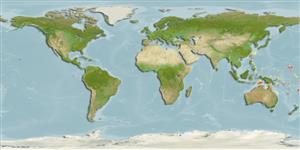>
Gadiformes (Cods) >
Macrouridae (Grenadiers or rattails)
Etymology: Coelorinchus: Greek, koilos = a hollow + Greek, rhyngchos = jaw (Ref. 45335); pardus: From the Greek pardus, the pard, leopard, in reference to its leopard-like spots.
More on authors: Iwamoto & Williams.
Environment: milieu / climate zone / depth range / distribution range
Ekologi
laut bentopelagis; kisaran kedalaman 107 - 187 m (Ref. 35909). Tropical
Western Central Pacific: confined to the Arafura Sea in the Northern Territory, Australia.
Size / Weight / umur
Maturity: Lm ? range ? - ? cm
Max length : 30.0 cm TL jantan/; (Ref. 35909)
Duri punggung (Keseluruhan (total)) : 2. Snout long, 43-49% of HL, anterolateral margin not completely supported by bone; characteristic scales overlap anterolaterally onto ventral snout surface; orbit diameter 22-25% of HL, 1.8-2.2 times into snout length; upper jaw 24-27% of HL; chin barbel short, about equal to length of first gill slit; subopercle lacking a prolonged narrow flap. Light organ extends from behind isthmus to front of anus. Underside of head naked; nasal fossa naked; body scales thin, spinules short, fine, aligned in close parallel rows. Conspicuous body markings consisting of blotches, spots and occasional ring on dorsum, becoming a narrow dorsal stripe to end of tail; belly between periproct and pelvic fin bases lacking melanophores; maxillary ramus immaculate (rarely with 2-3 melanophores). First dorsal fin with membrane between second spinous ray and first segmented ray black; anterior end of anal fin blackish distally. Pyloric caeca 8-11, usually 10-11; P i14-i15, rarely i16.
Found on the continental shelf. Benthic (Ref. 75154).
Life cycle and mating behavior
Kematangan | Reproduksi, perkembang biakan | Pemijahan | telur-telur | Fecundity | Larva
Iwamoto, T. and A. Williams, 1999. Grenadiers (Pisces, Gadiformes) from the continental slope of western and northwestern Australia. Proc. Calif. Acad. Sci. 51(3):105-243. (Ref. 35909)
Status IUCN Red List (Ref. 130435: Version 2024-2)
ancaman kepada manusia
Harmless
penggunaan manusia
Alat, peralatan
laporan khas
muat turun XML
Sumber internet
Estimates based on models
Preferred temperature (Ref.
123201): 20.9 - 23.6, mean 22.1 °C (based on 7 cells).
Phylogenetic diversity index (Ref.
82804): PD
50 = 0.5000 [Uniqueness, from 0.5 = low to 2.0 = high].
Bayesian length-weight: a=0.00245 (0.00126 - 0.00477), b=3.19 (3.02 - 3.36), in cm total length, based on LWR estimates for this Genus-body shape (Ref.
93245).
Trophic level (Ref.
69278): 3.5 ±0.5 se; based on size and trophs of closest relatives
Daya lenting (Ref.
120179): sedang, Waktu penggandaan populasi minimum 1.4 - 4.4 tahun (Preliminary K or Fecundity.).
Fishing Vulnerability (Ref.
59153): Low vulnerability (20 of 100).
